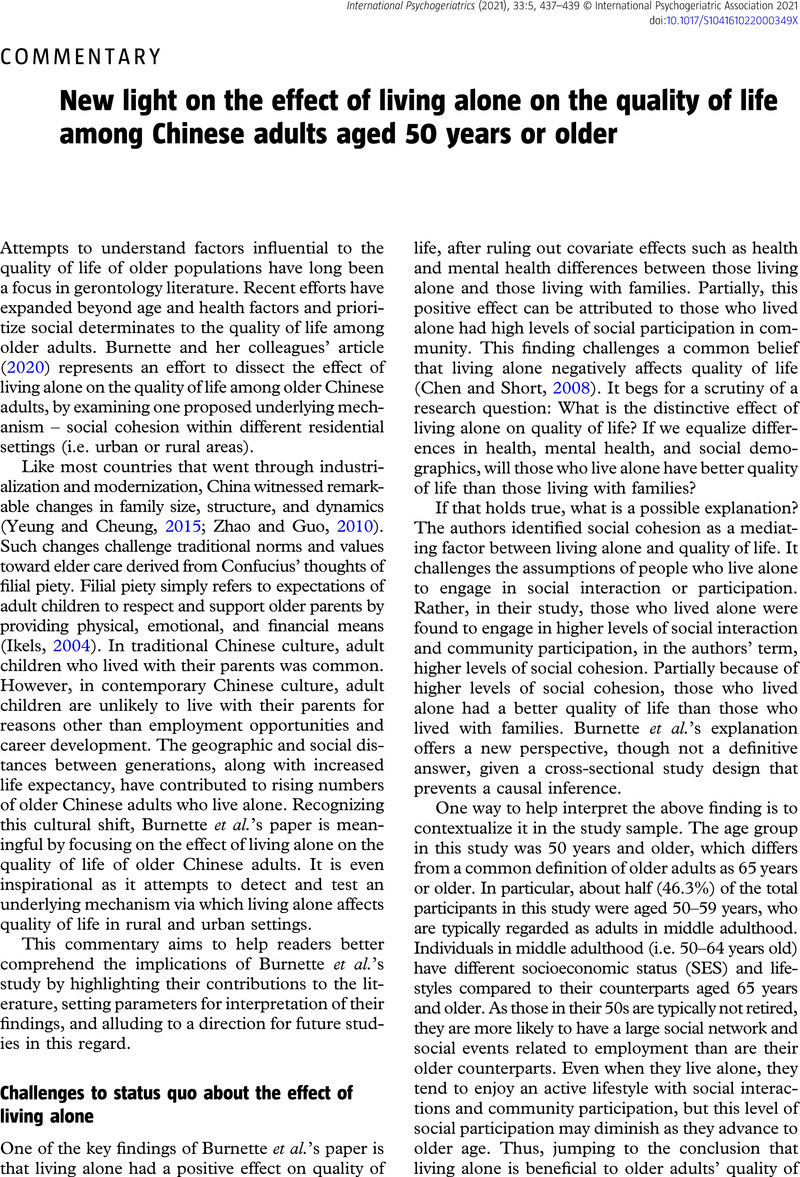No CrossRef data available.
Article contents
New light on the effect of living alone on the quality of life among Chinese adults aged 50 years or older
Published online by Cambridge University Press: 31 May 2021
Abstract
An abstract is not available for this content so a preview has been provided. Please use the Get access link above for information on how to access this content.

- Type
- Commentary
- Information
- International Psychogeriatrics , Volume 33 , Special Issue 5: Issue Theme: Loneliness and Social Connectedness , May 2021 , pp. 437 - 439
- Copyright
- © International Psychogeriatric Association 2021
References
Burnette, D., Ye, J. Z., Cheng, Z. W. and Ruan, H. Q. (2020). Living alone, social cohesion and quality of life among older adults in rural and urban China: a conditional process analysis. International Psychogeriatrics. doi: 10.1017/S1041610220001210.CrossRefGoogle Scholar
Chen, F. and Short, S. E. (2008). Household context and subjective well-being among the oldest old in China. Journal of Family Issues, 29
(10), 1379–1403.CrossRefGoogle ScholarPubMed
Goode, W. J. (1963). World Revolution and Family Patterns. London: Free Press of Glencoe.Google Scholar
He, C. and Ye, J. (2014). Lonely sunsets: impacts of rural-urban migration on the left-behind elderly in rural China. Population, Space and Place, 20
(4), 352–69.CrossRefGoogle Scholar
Ikels, C. (2004). Filial Piety: Practice and Discourse in Contemporary East Asia. Stanford, CA: Stanford University Press.Google Scholar
Jadhav, A. and Weir, D. (2018). Widowhood and depression in a cross-national perspective: evidence from the United States, Europe, Korea, and China. The Journals of Gerontology: Series B, 73
(8), e143–e153.CrossRefGoogle Scholar
Marmot, M. and Wilkinson, R. (Eds.) (2006). Social Determinants of Health, 2nd edition. Oxford: Oxford University Press.Google Scholar
Mcneill, L. H., Kreuter, M. W. and Subramanian, S. V. (2006). Social environment and physical activity: a review of concepts and evidence. Social Science & Medicine, 63
(4),
1011–1022. http://dx.doi.org/10.1016/j.socscimed.2006.03.012
CrossRefGoogle ScholarPubMed
Pocnet, C., Antonietti, J. P., Strippoli, M. P. F., Glaus, J.,
Preisig, M. and Rossier, J. (2016). Individuals’ quality of life linked to major life events, perceived social support, and personality traits. Quality of Life Research, 25
(11),
2897–2908.CrossRefGoogle ScholarPubMed
Sun, F., Li, W., Jiang, L. and Lee, J. (2020). Depressive symptoms in three Chinese older workforce groups: the interplay of work stress with family and community factors. International Psychogeriatrics, 32
(2), 217–227.CrossRefGoogle ScholarPubMed
Wang, J., Chen, T. and Han, B. (2014). Does co-residence with adult children associate with better psychological well-being among the oldest old in China? Aging & Mental Health, 18
(2), 232–239.CrossRefGoogle ScholarPubMed
Ye, J., He, C., Liu, J., Wang, W. and Chen, S. (2016). Left-behind elderly: shouldering a disproportionate share of production and reproduction in supporting China’s industrial development. The Journal of Peasant Studies, 1–29. http://dx.doi.org/10.1080/03066150.2016.1186651
Google Scholar
Yeung, W. J. J. and Cheung, A. K. L. (2015). Living alone: one-person households in Asia. Demographic Research, 32
(40), 1099–1112. http://dx.doi.org/10.4054/DemRes.2015.32.40
CrossRefGoogle Scholar
Zhao, Z. and Guo, Z. (2010). China’s below replacement fertility: a further exploration. Canadian Studies in Population, 37, 525–562.CrossRefGoogle Scholar


